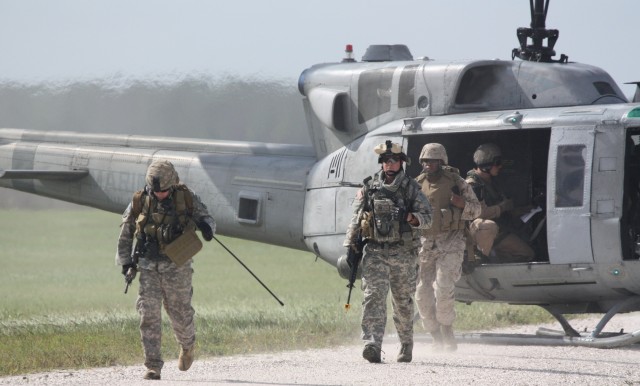AVON PARK, Fla. (Army News Service, Sept. 23, 2010) -- Soldiers, along with troops from other services, and military members from Canada and Slovenia, trained together to improve their close-air-support skills during the recent Atlantic Strike 10-02 exercise.
Soldiers from the 25th Infantry Division out of Schofield Barracks, Hawaii, participated in the exercise, led by the Air Force's Air Combat Command and U.S. Joint Forces Command's Joint Fires Integration and Interoperability Team at the Avon Park Air Ground Training Complex.
"The experience we gain by integrating our JFOs with this joint and coalition training audience will pay dividends on the battlefield where it matters most," said Army Maj. Nathaniel Edwards, a fires support officer with the 3rd Brigade Combat Team, 1st Armored Division.
The Atlantic Strike 10-02 exercise trained warfighters to find, fix, track, target, engage, and assess both fixed and moving ground targets.
"Atlantic Strike is the quintessential air-to-ground training exercise that provides joint terminal attack controllers, Army joint fires observers, and aircrews with the skills they need to effectively work together to achieve both lethal and non-lethal effects on the battlefield," said Marine Corps Maj. Jabari Reneau, JFIIT's Atlantic Strike exercise director. "This training will ultimately improve our combat effectiveness while reducing the potential of fratricide and collateral damage during combat operations."
Exercise planners hope the experience will help foster trust, increase confidence and build vital relationships between key members of air-to-ground teams, said U.S. Air Force Maj. Gen. David L. Goldfein, director of Air and Space Operations for Air Combat Command.
"Important relationships are being forged here, just like they must be on the battlefield, when you can look your comrade in the eye and know you can count on each other," he said. "That's what Atlantic Strike provides our warfighters."
More than 240 participants, CAS subject matter experts, observers, and support personnel participated in the combined and joint exercise.
"Atlantic Strike gave us an excellent opportunity to work with the U.S. military and other partners," said Canadian Forces Capt. Jonathan Cober, an instructor with the CF Forward Air Control Cell. "Our primary purpose at this exercise was the opportunity to look at the digital CAS technologies used here and to practice key air-to-ground linkages with some of our most important partners."
An added advantage of Atlantic Strike was its ability to focus on the training audience's needs, according to senior leaders at the exercise.
"One of the strengths of Atlantic Strike is that it is scalable and still able to focus on specific training objectives," Goldfein said. "We're 100 percent focused and committed to the current fight as we keep an eye on the next threat. We know to accomplish that task we must be good joint partners, and this exercise is an example of that commitment."
The exercise improved joint air-to-ground training of Air Force and Marine Corps JTACs, Army JFO teams, the Air Support Operations Center, and aircrew by incorporating intelligence, surveillance, and reconnaissance assets along with real-time, full-motion video to replicate a realistic and stressful combat environment similar to operations in Afghanistan.
"Our primary goal was to get as many controls of live CAS aircraft as we could," said Senior Airman Benjamin Schmidt from Detachment 2, 1st Air Support Operations Squadron. "Atlantic Strike gave us the opportunity to work with a variety of aircraft and the entire air-to-ground kill chain just like we will in combat. This is as about as real-world as it gets for us, and it will ultimately help us perform our mission downrange."
During Atlantic Strike, JTACs and JFOs trained on critical CAS tactics, techniques, and procedures during several near-real-world scenarios, including convoy operations, cordon and search, counter-sniper, counter-ambush, and counter-improvised explosive device operations in both day and night conditions.
"One of our key challenges is to figure out how we can conduct sustainment training to maintain the certification of our Army JFOs," Edwards added. "Atlantic Strike offers a superb, realistic, live-training venue where we can provide our JFOs with the experience they need to hone their skills, keep them up-to-date on current CAS TTP, and have them better prepared to support the maneuver force during stressful combat conditions."
To enhance training, the exercise leveraged several air platforms and capabilities. That included the Air Force's B-52 Stratofortress and F-16 Fighting Falcon, the Marine Corps' UH-1 Iroquois and AH-1 Cobra helicopters, and a surrogate unmanned aircraft system.
"One of our goals was to provide the training audience with a variety of air assets much like they will see in theater," Reneau said. "We owe them the best training experience before they deploy, and we believe Atlantic Strike is an important part of their go-to-war training."
Atlantic Strike enhanced the training experience by using video downlink technology. Using equipment like the Remotely Operated Video Enhancement Receiver and VideoScout enabled JTACs and JFOs to view near-real-time video from airborne sensors.
"The value of this exercise is that it allows our personnel to look at new TTPs, technologies, and best practices from theater to be better prepared when called upon," Goldfein said. "We've got to stay one step ahead of the enemy, and Atlantic Strike helps us to do exactly that."
(Casey E. Bain writes for JFIIT, USJFCOM)


Social Sharing